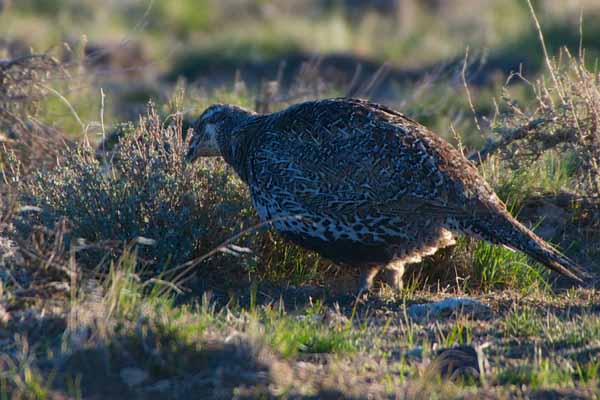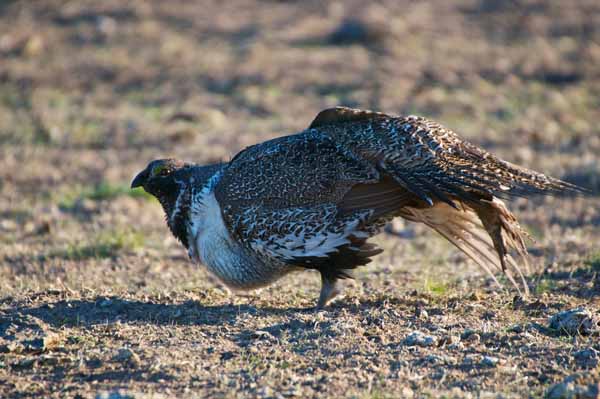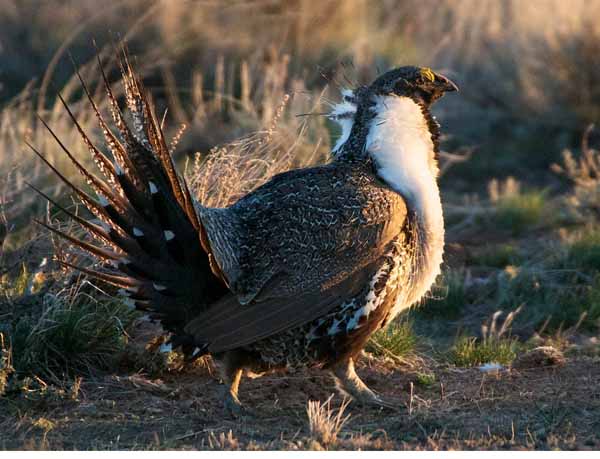It’s a sight I have come to both dread and expect: sagebrush country reduced to cinders.
Most recently, I saw this happen to a favorite place in southwestern Idaho where I’ve hiked and hunted for twelve years, an area where head-high sagebrush provided cover for mule deer and prairie falcons and white-tailed jackrabbits. And sage grouse.
That beautiful mix of plants and wildlife had been replaced by black, bare earth. Fire may be an essential part of forests, but too-frequent fires in sagebrush country function like a welcoming party for non-native weeds. They move in and take over, turning once-diverse land into a monoculture.
It’s a story being repeated around sagebrush country in the West. Pioneers once looked out across the high desert plains and considered it endless. They called it the sagebrush sea.
But as with most things people consider endless: it wasn’t. Today the country is being reduced to small islands of habitat. Fire and non-native weeds claim many acres of the haibtat here in Idaho. Elsewhere, it’s energy development and even the encroachment of trees.
“Once Humpty Dumpty falls off the wall, you can’t put him back together again,” says Dr. Dave Naugle, a professor of large-scale wildlife ecology at the University of Montana. “It’s the same with sagebrush habitat. Once it gets broken up, you can’t piece it back together again either.”
Naugle was speaking at the Theodore Roosevelt Conservation Partnership media summit, an annual gathering of conservation writers, reporters and thought leaders held this year in Bismarck, North Dakota.
He spoke at the summit as scientific advisor for the Sage Grouse Initiative, an ambitious effort of the Natural Resources Conservation Service that enables local leadership and local solutions for grouse conservation. The initiative aims is to keep the sage grouse off the Endangered Species List by working with local ranchers and others.
Its ultimate goal: keep high-quality sage grouse habitat intact.
“If you read 200 papers on sage grouse, you’ll be left with one main message. Grouse hate fragmentation. It’s that simple,” says Naugle. “They cannot thrive with any kind of fragmentation. They need big and intact native rangelands to flourish.”
Naugle exudes optimism and positive energy, which at first glance might seem odd traits for someone focused on sage grouse and sagebrush rangelands. Only ten percent of high-quality sagebrush habitat remains. And as goes sagebrush, so goes sage grouse. The birds eat it, nest in it, rely on it for cover. It’s no surprise that grouse populations have been in long-term and precipitous decline.
And with increased energy demands, increased fire and encroaching juniper trees, how could anyone remain positive about the sage grouse’s future?

Naugle doesn’t strike me as a Pollyanna. His excitement is based on years of observation on what works and what doesn’t in conservation, and he’s convinced of this: the Sage Grouse Initiative’s approach could be a new model for addressing imperiled species issues.
“We’re taking the science and turning it into solutions,” he says. “We recognize that when sagebrush is torn up, the impact is forever. So we’re using the science to show us how to keep the best habitat intact, while still coexisting with other uses of the land.”
One recent paper in PLoS One (coauthored by the Conservancy’s Holly Copeland) called it “one of the largest conservation experiments ever undertaken in North America.”
A crucial component: take the latest peer-reviewed science and apply it immediately on the ground. Time is ticking, and rapid results are necessary.
The Nature Conservancy, a partner in the initiative, has been highly involved in providing the research.
One recent paper examined the use of Wyoming’s core area strategy, which protects the highest quality sage grouse habitat while allowing energy development in less sensitive areas. This paper echoes a theme I heard repeatedly at the TRCP summit: we need energy, yes, but let’s do it in a way to reduce impacts on sage grouse and other wildlife. (To read more about this paper, read my recent blog “Can Protecting Core Areas Help Imperiled Sage Grouse Populations?”).
Another study published in Biological Conservation examines the benefits of removing juniper trees from sagebrush habitat. Junipers are native, but they have been rapidly spreading. In southwestern Idaho, for instance, junipers are spreading at a rate of 2500 acres per year.
Sage grouse avoid anything that provides perches—like juniper–for predators and scavengers like golden eagles and ravens.
“Our key finding is that grouse populations are unable to make a living once encroaching trees occupy more than 4% of their habitat,” says The Nature Conservancy’s Dr. Sharon Baruch-Mordo, lead author of the study.
One of the efforts of the Sage Grouse Initiative is to target trees in areas where it can make the most difference for grouse.
“Early tree removal is highly effective and less costly than a delay-and-repair approach that tries to turn a forest back into a sagebrush ecosystem again,” says Naugle.
And that’s the case with so many of the initiative’s projects: use science to make a difference now. While there’s time. Before the grouse is listed. While we still have intact sagebrush habitat and viable grouse populations.
“We are pushing the accelerator as fast as we can to achieve lasting conservation results,” says Naugle. “This is an ambitious conservation science effort. But it’s not just research. We don’t have a lot of time here. We need to put that research on the ground. Fortunately the Sage Grouse Initiative has the partners and local support to do just that.”





Matt:
Thank you for a great piece of writing about the Sage Grouse.
As a young teenager, I traveled with my father, Dr. Paul Dalke, who was the first leader of the Idaho Cooperative Wildlife Research Unit, 1947-1967. Anytime I could “wiggle” a trip with him, I was out the door.
In particular he took me to the “booming grounds, to watch the males “strut their stuff”, and nesting grounds of the Sage Grouse between St. Anthony and Kilgore. I remember counting the sage grouse nests, number of eggs in those nests, and nests with no eggs. It was an interesting experience, of which part has translated into an alphabet, poetry book, I am writing about the State of Idaho.
Thanks again for this piece of reporting and your research with the Sage Grouse.
Sincerely,
Martha Hindman
Why is the juniper encroaching, if not due to fire-suppression?
Thanks for writing. Fire suppression is part of it, as is improper grazing management and likely climate change.
Fire management in sagebrush country is complicated. Too-frequent fire allows annual, non-native grasses like cheatgrass to come in and take over. Anyone who follows fire in the west has seen this story repeat itself again and again. Yes, fire is a natural part of sagebrush country — as long as it is infrequent. Now, the risks of fire to sagebrush habitat are huge — in my 13 years living in Idaho I have seen thousands and thousands of acres of prime wildlife habitat replaced by monocultures of cheatgrass due to too-frequent fires.
Great article. Time is ticking and we need all the support we can get.
Matt–
What an outstanding piece. You capture the issue with great clarity. Sage grouse hate fragementation of large sagebrush-steppe. And then put forward the science and partnership that’s guiding delivery of conservation to keep the biggest best habitats intact via the Sage Grouse Initiative. Plus as someone who knows Dave Naugle, you’ve caught his positive fire on the subject.
Many thanks.
Deborah, SGI Communications Director